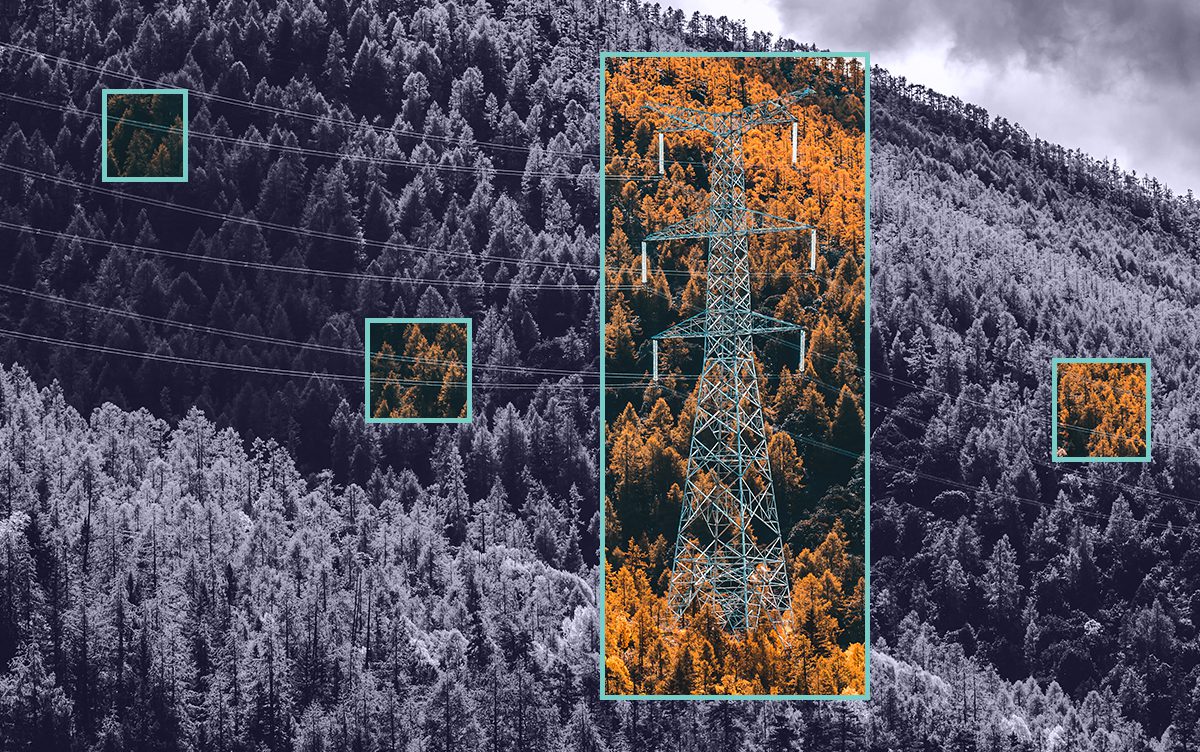Vegetation management is critical to the reliable and efficient operation of utility infrastructure. It involves the proactive and strategic control of vegetation around power lines, pipelines and other crucial infrastructure.
Historically, monitoring vegetation growth was a significant obstacle in the management process. It was costly, time-consuming and could only be performed relatively infrequently. With the advent of advanced imaging solutions and AI-powered platforms, that is all changing.
This guide aims to provide a comprehensive understanding of the importance of vegetation management for utility companies. It also highlights the technological changes that are taking place, facilitating a new, more effective approach.
What is vegetation management?
In the context of utilities infrastructure, vegetation management refers to the process of monitoring, maintaining and controlling vegetation in and around infrastructure systems. These systems include power lines and pipelines but also extend to other infrastructure, such as roads, railways and buildings.
Vegetation management involves planning, implementing, and maintaining measures to ensure that vegetation does not interfere with the proper functioning and safety of the infrastructure. To mitigate the risks associated with overgrown or infringing vegetation, those responsible for vegetation management will often perform the following activities:
- Inspections – assessing vegetation growth and identifying areas that require attention or pose risks to infrastructure.
- Pruning and trimming – trimming tree branches, shrubs and any other vegetation that may pose a risk to maintaining safe clearances around infrastructure.
- Herbicide application – applying approved herbicides to control the growth of unwanted vegetation in critical areas.
- Tree removal – cutting down trees that pose a risk to infrastructure. This might include trees that are leaning towards power lines or that show concerning signs of decay.
- Vegetation clearing – clearing low-lying vegetation in areas that are prone to fires or hamper access to the infrastructure itself.
- Regular maintenance – implementing vegetation management initiatives that ensure vegetation growth is monitored and controlled over an extended period.
Why is vegetation management important?
Vegetation management is critical in maintaining infrastructure and ensuring the safety, reliability and efficiency of key infrastructure systems. It also helps to minimise disruptions to these systems caused by uncontrolled vegetation growth.
Several issues can arise when utilities organisations do not implement appropriate vegetation measures. Some of the common problems caused by unmanaged vegetation include:
- Obstruction – overgrown vegetation can obstruct the visibility of vital signs and signals, resulting in situations where there are no appropriate warnings or instructions. This can prove dangerous.
- Structural damage – tree roots penetrate beneath pavements, roads and building foundations, causing cracks and damage to the infrastructure’s structural integrity.
- Power outages – trees and branches that come into contact with power lines often cause electrical faults, leading to power outages, disruptions and safety hazards. This all contributes to higher costs for the utilities company.
- Fire hazards – dry and dead vegetation increases the risk of wildfires, which can cause untold damage and are difficult to control. In this sense, vegetation management is a preventative measure.
- Maintenance costs – uncontrolled vegetation growth is typically more expensive to remedy than smaller, more regular works. Similarly, poorly designed initiatives cost more than those that utilise modern technologies to optimise management strategies.
FlySight and i-EM vegetation management solutions
FlySight and i-EM have demonstrated that our OPENSIGHT and x-EM solutions can be used to improve vegetation management processes by optimising the inspection process and reducing overall costs. By utilising advanced AI-powered software solutions, utility companies can detect existing risk areas, predict future risk areas and assist with disaster management.
Our solutions utilised Earth Observation (EO) satellite imaging to acquire data without the need for feet on the ground. We can compare this with historical data and images to detect changes in vegetation and the extent of those changes. This information feeds into the AI-powered platform, which assesses risks and provides details that inform vegetation management decision-making.
While we initially tested our solutions on power line infrastructure, there is no reason we cannot apply the technology to other areas in the utility sector.
How does vegetation management benefit utilities companies?
Vegetation management benefits utilities providers in four key ways. They are:
- Minimising infrastructure safety concerns
- Reliability and service continuity
- Environmental stewardship
- Cost-efficiency
Let’s look at each of those in greater detail.
1. Minimising infrastructure safety concerns
Safety is the foremost concern for utilities companies, and effective vegetation management significantly contributes to ensuring a safe working environment. Potential safety concerns include fire hazards and electrical hazards, such as arcing, short circuits and power outages. These put the public, utility workers and property at risk.
Vegetation management minimises the risk utilities providers are exposed to, preventing damage to critical systems, safeguarding individuals and limiting the potential for reputational damage, costly repairs and personal payouts that result from infrastructure incidents.
Unmanaged vegetation also obstructs access to utility equipment, making it difficult for technicians to perform maintenance and repairs. This makes such work more time-consuming, expensive and dangerous. It also hampers the emergency response when things do go wrong.
2. Reliability and service continuity
Vegetation interference is a leading cause of service interruptions in the utility sector. By proactively managing vegetation, utilities companies enhance system reliability and limit unplanned outages. This is typically achieved by maintaining clearance distances to prevent accidental contact.
Vegetation management also plays a role in ensuring storm resilience. Well-managed vegetation is more resilient to severe weather events, such as storms, high winds and heavy snow. Removing weak, diseased or dead trees minimises the risk of damage and service interruptions.
3. Environmental stewardship
Advanced vegetation management practices also enable utilities companies to protect their assets in a more environmentally-friendly and sustainable manner. Rather than indiscriminate clearing, companies can adopt a selective approach based on data-driven insights. This approach allows organisations to preserve beneficial vegetation while managing potentially hazardous or incompatible species.
It also allows for improved habitat preservation. By collaborating with conservation organisations and leveraging data, utilities providers can identify opportunities for preserving and enhancing habitats for native flora and fauna. This contributes to greater biodiversity and a more healthy ecosystem.
4. Cost efficiency
Though vegetation management requires investment, strategic management yields significant cost savings in the long run. Considering how vegetation management is one of the principal costs associated with powerline maintenance, there are considerable savings to be made by adopting a more informed approach.
Cost savings are made in several ways. By proactively managing vegetation, utilities companies mitigate the risk of vegetation-related emergencies, reducing associated response costs, equipment damage and service restoration expenses. Effective management also extends the expected lifespan of utility infrastructure by reducing the impact of vegetation-related stressors.
Finally, vegetation management makes utility infrastructure more accessible, allowing engineers to perform their tasks more efficiently and safely and reducing the time required for maintenance, repairs and inspections. This improves overall operational efficiency and reduces costs.
Vegetation management FAQs
Below, we explore some of the most frequently asked questions we receive on the topic of vegetation management.
What kind of savings do FlySight and i-EM vegetation management generate?
While savings depend on how well our technology is implemented and employed, utilities organisations can drastically reduce the amount they spend protecting their infrastructure assets by facilitating a more strategic approach to vegetation management and automating monitoring.
What technologies does the FlySight and i-EM solution rely on?
In the SP4GO- ESA recent project, we paired FlySight’s OPENSIGHT AI solution with i-EM’s x-EM business intelligence platform to refine vegetation management processes. These technologies utilised Earth Observation (EO) and Positioning, Navigation and Timing (PNT) space assets as reliable sources of mapping data and information.
What are OPENSIGHT and x-EM?
FlySight OPENSIGHT is a real-time visualisation and decision-making tool incorporating an innovative geo-exploitation toolbox. It enables organisations to leverage geographical mapping data to inform strategic and operational decisions.
x-EM is a smart grid solution from i-EM. It helps organisations manage energy solutions, improving their resilience and optimising performance. It also helps to optimise infrastructure maintenance, which is particularly useful in the context of vegetation management.
Is this a proven solution?
The recent SP4GO demo trial demonstrated FlySight and i-EM’s ability to deliver vegetation management solutions. It showed that our solutions provided excellent value to Transmission System Operators (TSOs) responsible for power lines by detecting vegetation clearance issues and assessing other vegetation risks.
The future of vegetation management is here
Vegetation management is of paramount importance for utilities companies due to its significant impact on safety, system reliability and cost efficiency. By implementing proactive and sustainable vegetation management strategies, utilities companies can ensure the uninterrupted delivery of services, minimise safety risks and optimise operations.
FlySight and i-EM have demonstrated that our technologies can play a crucial role in revolutionising the processes that underpin vegetation management by introducing AI-driven automation and improved strategic planning. This benefits utilities companies in every way, from improved safety to greater efficiency and reduced costs.




